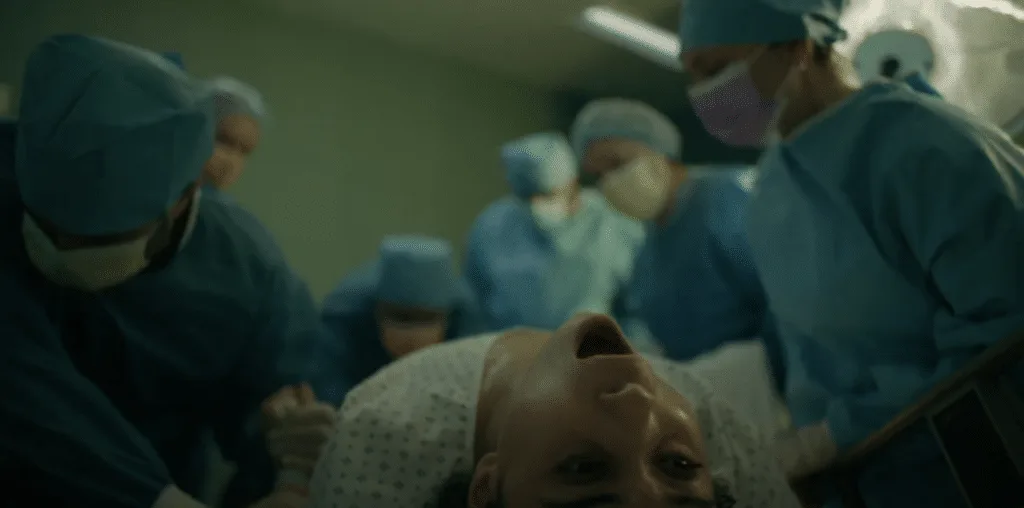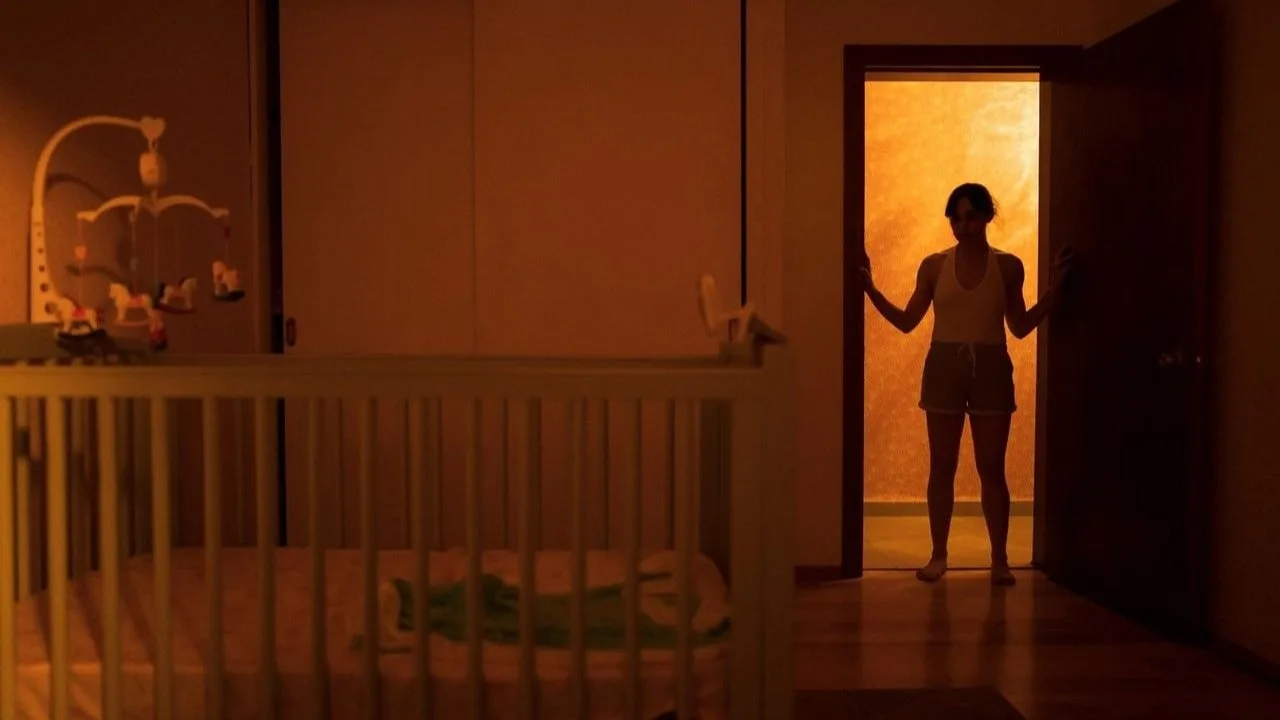
By contributor Gabby Foor
Motherhood, for me, was always an idea laced with fear. From the time I could understand my mother’s aches and pains from having me, I wondered at the fate of a mother and if I wanted to bear that myself. As nameless as the entity that stalks Valeria (Natalia Solian) is, so too is the unnamed pressure women bear, from the moment they are given their first baby doll to becoming mothers. We don’t know why we are given this task, but it is assumed we are to bear children one day, or disappoint. Michelle Garza Cerveza’s debut tosses tired pregnancy tropes and reinvigorates them with both new levels of bodily discomfort, black magic, colorful light and camera work and complex characters. Huesera: The Bone Woman takes the power of a supernatural entity and the very real haunting pressures and judgements that follow us as women, and molds it into a maternal tale that creates an almost literal cacophony of anxieties.
Between medicine and religion, is where we find Valeria and her husband Raul (Alfonso Dosal) trying to get pregnant with the help of their doctors and prayer. Classic beliefs, in that even after a doctor visit, my mother and I still light candles for health anyway. Much to both their joy they succeed, but it doesn’t take long for things to take a sour turn for Valeria who seems to see reminders of children everywhere. Valeria will have to give up her workshop in order for it to be a nursery and is already dealing with a nosy mother in law who doesn’t respect her craft to build a crib. To pile on, come Mother’s Day, of all days, her own family makes it plain, through the vicious verbal woman-on-woman crime most girls are familiar with, that they find her pregnancy almost laughable. They ask if she’s even held her nieces and nephews and humiliate her with a story of when she was younger and babysat a neighbor boy, accidentally dropping him down the stairs. The good news is at least she’s not a spinster like her aunt Isabel (Mercedes Hernandez), the only woman to offer her any comfort and to recognize her budding nervous dependency of cracking bones. Certainly, don’t look to her husband for support during the film; he’s fine to let her take emotional battery here and there.
After a brief but tense run-in with an old friend from her punk rock days, Octavia (Mayra Batalla), Val’s reminded of the choices that led her to this domestic life. Nervous ticks and bad habits start to pierce the exhausted veil for Valeria, and her husband isn’t interested in touching her anymore in case it “hurts the baby.” On another sleepless night, Valeria witnesses what looks like a woman climb out of her window and jump to the street below, shattering her skeleton. Terrified, she realizes the woman isn’t dead but is instead moving and crackling below, attempting to reach out with a distorted face. She frantically tries to show Raul the disfigured body, but is despondent when she sees that the woman missing. After this episode, it’s back to the doctor who sees that she’s lost weight, has anaemia, no appetite and intense morning sickness. The cure? Finish getting rid of your workshop, only bringing up more memories of the life with Octavia she left behind, followed by more haunting occurrences tied to this entity.
Cerveza does an excellent job with pacing this film as the middle does slow down, but instead of focusing on the supernatural closes in on the personal difficulties. The fear comes in two flavors of the emotional and the visceral for me, personally. Valeria’s identity and desires are stripped down from beginning to end. The viewer is given an interesting perspective at the film’s conclusion, and somewhat of a choice, as to what Valeria may or may not want, and I love this playfulness. But up until the very end watching her independence and spirit get picked raw was frightening, from the shouts of “I don’t like domestication!” from her past to the cries of labor, we watch her evolution and deconstruction. Val used to be rebellious, an array of dark colors compared to this pleasing suburban paint sample. Her pregnancy made her just another nameless, aimless “mommy”, and she is forced to dismantle her passions and her body on her own terms for the baby and for the satisfaction of her family and husband. This is above all why motherhood scares me: the loss of self.
The visceral fear credit should go to whoever designed and edited the audio for this film, in this case Christian Giraud. When Valeria is haunted by this entity, it is signalled by the disturbing chorus of snapping of bones. The sounds are so real, so perfectly human and so loud it is like it’s in the room with you, and can have you grabbing at your own joints for reassurance. This fleshy marrow crunch radiates through you. As Valeria gets anxious and cracks her knuckles, neck and back in a skeletal orchestra you dread that the entity may be about to appear, with twisting limbs or hands reaching out to rip or grab. Similarly, as the atmosphere gets intense around Val, you can hear sounds swell, like a television or other background noise that in real life, can become all too much when things in your head are more than you can bear. The use of sound to overwhelm the viewer in the same way Valeria is feeling these intense emotions is experiential and hasn’t happened since my theater viewing of Sinister, with its constant oppressive droning soundtrack that beats its viewer into submission with pure noise. Closing your eyes offers no respite here.
Huesera: the Bone Woman will likely leave a lot of viewers with questions on their lips. Huesera, a mysterious word itself, means “bonemaker” or “bonesetter,” similar words are to that of “chiropractor”; maybe this will give a little life to the title and Valeria’s constant need to realign. The entity, the ritual and the way by which Valeria is given a second chance at life are never really given names or explanations, only intense visuals and suggestion for the viewer to act on. These prayers and rituals remind me of the ones my family has done, filling my nose with the scent of sage and Florida Water sprayed over me as my mother gently prays, “Sana sana colita de rana…” an old Spanish rhyme to help me when I felt ill or burdened. As Valeria is broken to pieces, I am reminded in the film’s final scene why I myself own the style of ceramic that the women are sipping from: kintsugi or “gold joinery,” the Japanese art of mending broken pottery with precious metals. Though we and Valeria may be broken at times, we can refill the seams with something beautiful to show for our pain, and these women, as they sit bonded like pieces of pottery in the aftermath of ritual and reconciliation that they will carry for life, are nothing short of stunning.
Huesera is available now to stream or to buy.
